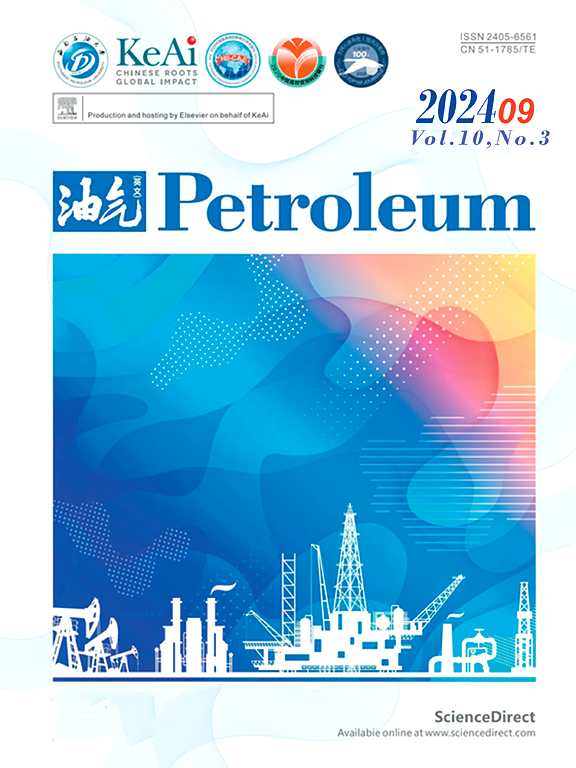An environmentally friendly and low-cost alginate-based gel for water management in petroleum reservoirs: Characterization and efficacy investigation
IF 4.2
Q2 ENERGY & FUELS
引用次数: 0
Abstract
Water production in petroleum reservoirs poses considerable challenges, such as lower production efficiency, higher operational costs, and severe environmental risks. This study investigates the effectiveness of a novel, sustainable, and economical alginate-based gel system derived from Persian Gulf brown algae in decreasing reservoir rock water permeability. The ultrasonic-assisted method retrieved the most alginate, yielding 56% at a pH, alginate-to-water ratio, sonication time, and ultrasound power of 11, 10 g/L, 45 min, and 75 W, respectively. The FTIR spectrum showed that the alginate structure had O–H, C–H, C![]() C, and C–O functional groups. Also, TGA results indicate that the extracted alginate is thermally stable. The effects of polymer concentration, cross-linker content, pH, temperature, and solvent salinity on the properties of the natural gel system were investigated. While the gel strength rose with increasing polymer and cross-linker concentrations, the gelation time decreased. Also, increasing the acidity of the system resulted in higher gel viscosity, attributed to stronger molecular binding. Seawater-based gels exhibited greater strength than distilled water gels due to divalent ions (Mg2+, Ca2+) in seawater. The sand-pack experiments demonstrated the ability of the polymer-gel system, which included 3 wt% of the alginate polymer and 1 wt% of CaCl2, to reduce permeability by 44.7%. Furthermore, the coreflood experiments conducted on a carbonate reservoir rock demonstrated the feasibility of in-situ gel formation and a 22.7% reduction in permeability by injecting a 0.5 wt% alginate solution. The results showed that the sustained gel functioned as a blocking agent by significantly diminishing the water permeability.
C, and C–O functional groups. Also, TGA results indicate that the extracted alginate is thermally stable. The effects of polymer concentration, cross-linker content, pH, temperature, and solvent salinity on the properties of the natural gel system were investigated. While the gel strength rose with increasing polymer and cross-linker concentrations, the gelation time decreased. Also, increasing the acidity of the system resulted in higher gel viscosity, attributed to stronger molecular binding. Seawater-based gels exhibited greater strength than distilled water gels due to divalent ions (Mg2+, Ca2+) in seawater. The sand-pack experiments demonstrated the ability of the polymer-gel system, which included 3 wt% of the alginate polymer and 1 wt% of CaCl2, to reduce permeability by 44.7%. Furthermore, the coreflood experiments conducted on a carbonate reservoir rock demonstrated the feasibility of in-situ gel formation and a 22.7% reduction in permeability by injecting a 0.5 wt% alginate solution. The results showed that the sustained gel functioned as a blocking agent by significantly diminishing the water permeability.
一种环境友好、低成本的海藻酸盐基油藏水管理凝胶:表征和效果研究
油藏采水面临着诸多挑战,如生产效率低、作业成本高、环境风险严重等。本研究探讨了一种新型的、可持续的、经济的海藻酸盐凝胶体系在降低储层岩石渗透率方面的有效性。超声辅助法在pH、海藻酸与水比、超声时间和超声功率分别为11、10 g/L、45 min和75 W时,提取海藻酸盐最多,回收率为56%。FTIR光谱表明,藻酸盐结构具有O-H、C-H、CC和C-O官能团。TGA结果表明,提取的海藻酸盐具有热稳定性。考察了聚合物浓度、交联剂含量、pH、温度和溶剂盐度对天然凝胶体系性能的影响。随着聚合物和交联剂浓度的增加,凝胶强度增加,凝胶时间缩短。此外,增加体系的酸度导致更高的凝胶粘度,这归因于更强的分子结合。由于海水中的二价离子(Mg2+, Ca2+)的存在,海水基凝胶比蒸馏水凝胶表现出更高的强度。填砂实验表明,聚合物-凝胶体系(其中含有3wt %的海藻酸盐聚合物和1wt %的CaCl2)能够降低44.7%的渗透率。此外,在碳酸盐岩储层上进行的岩心驱油实验证明了原位凝胶形成的可行性,通过注入0.5 wt%的海藻酸盐溶液,渗透率降低了22.7%。结果表明,持续凝胶的阻水作用显著降低了水渗透性。
本文章由计算机程序翻译,如有差异,请以英文原文为准。
求助全文
约1分钟内获得全文
求助全文
来源期刊

Petroleum
Earth and Planetary Sciences-Geology
CiteScore
9.20
自引率
0.00%
发文量
76
审稿时长
124 days
期刊介绍:
Examples of appropriate topical areas that will be considered include the following: 1.comprehensive research on oil and gas reservoir (reservoir geology): -geological basis of oil and gas reservoirs -reservoir geochemistry -reservoir formation mechanism -reservoir identification methods and techniques 2.kinetics of oil and gas basins and analyses of potential oil and gas resources: -fine description factors of hydrocarbon accumulation -mechanism analysis on recovery and dynamic accumulation process -relationship between accumulation factors and the accumulation process -analysis of oil and gas potential resource 3.theories and methods for complex reservoir geophysical prospecting: -geophysical basis of deep geologic structures and background of hydrocarbon occurrence -geophysical prediction of deep and complex reservoirs -physical test analyses and numerical simulations of reservoir rocks -anisotropic medium seismic imaging theory and new technology for multiwave seismic exploration -o theories and methods for reservoir fluid geophysical identification and prediction 4.theories, methods, technology, and design for complex reservoir development: -reservoir percolation theory and application technology -field development theories and methods -theory and technology for enhancing recovery efficiency 5.working liquid for oil and gas wells and reservoir protection technology: -working chemicals and mechanics for oil and gas wells -reservoir protection technology 6.new techniques and technologies for oil and gas drilling and production: -under-balanced drilling/gas drilling -special-track well drilling -cementing and completion of oil and gas wells -engineering safety applications for oil and gas wells -new technology of fracture acidizing
 求助内容:
求助内容: 应助结果提醒方式:
应助结果提醒方式:


